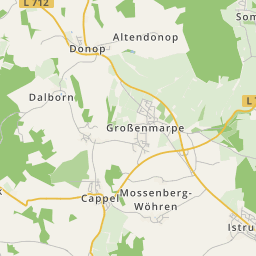











The Lipper is reliable. He preserves, doesn't throw anything away and doesn't like to rebuild. This virtue hampers progression, at times, but saved the urban treasures.
They stem from the 13th-century, when towns were founded in the region on the drawing board.
The Cherusker-Path runs, for example, via the front, or rather back street around the historical centre of Lemgo and Detmold. At the town gate the side streets unite with the middle road. Blomberg and Lüdge were also created after this Lippe three-street-scheme.
The urban development is a special feature in the Lippe treasure trove.
Lipper panoramas! Below the Earl's View at the Burgbergweg, the red sea of roofs of Schwalenberg sprawls out in front of you. Like a swallow's nest, the painter and national costume town snuggles up to the Burgberg. The small farming town shines with its closed half-timbered landscape. Desires, hopes and religious sayings can be seen on the beams. Richly decorated ornament gables with colourful fan rosettas, ornate meandering flower motifs and delicate crenulations remind one of the Wesrerrenaissance's heydays.
Along trade route the Italian example came all the way to the Weser and into the Lipper-Land. The original stone decorations were being replaced by Lippe citizens simply by wood. The Lipper makes do with whatever is available to him.
There is a lot ot marvel at in Schwalenberg: At the start of the 20th-century, numerous open-air painter flocked here to be inspired by the special light above the Mörth. Is their spirit still in the air?
In any case, galleries and art exhibitions are to be found at every corner. At the Robert Koepke House, one can view the facade of a typical Lippe four-post half-timbered house.
The building, divided into three parts was used manifold in the past: In the front wing, the people slept, cooked and ate, the back building was used for housing the cattle and in the front middle house stood the harvesting carriage. Today, there are changing exhibitions in the whole house to be seen. The large, richly decorated arched gate in the front are conspicuous in the whole of the Lippe land. Through these, the urban farmers manoeuvred the harvest of their fields. With the Plögge – a wooden hoist with a hook – the load was put on the floor. But why have semicircular stones in the portal? Very easy: They were wheeling deflectors for the large wooden wheels for the often heavily loaded carts.
The Lipper is very attached to his land. He nurtures bygones, whether castle, palace or windmill.
Thus, the citizens of Bavenhausen for example, lovingly replaced the sails of their 150 year old landmark, which were lost during a thunderstorm, a long time ago. The view wanders over the soft rolling knolls of the Kalle-Valley, which are descending towards the north to the Weser. The corn fields shimmer in yellow. The hiker goes on, on the pretty Kalle-Valley-path, eager to for the next view.
Here, you won't find overdevelopment of whole regions, rural structures are still intact in the whole land. There ares till many treasures to be extracted, one has to find them though. Best on foot. The Lipper doesn't let them go easily.